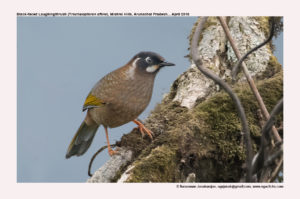Black-faced Laughingthrush

Black-faced Laughingthrush Garrulax affinis
Etymology :
- Garrulax : Latin word garrulous –babbling, chattering; ax – inclining towards
- Affinis : Latin word for “ Related”
Distribution in India: Resident of Himalayas in India.
Description: Size of 24–26 cm; Wt. of 52–85 g. It is a fairly large, dark brownish laughingthrush, scaled above and streaked below pale grey, with blackish-brown head and short rounded white submoustachial patch. The nominate race has crown dark brown, paler on nape, and rufescent mid-brown on mantle, shading to rufescent olive on upperparts with vague grey subterminal smudges and neat narrow dark scale-shaped tips. The rump and uppertail-coverts are dull pale chestnut; primary coverts are black, flight-feathers are fringed pale grey with broad golden-olive wing flash, tail is dull golden-olive basally, grey distally. The side of face is blackish, with white vertical patch behind ear-coverts and bolder creamy-white drop-shaped upper submoustachial and malar patch. The chin is blackish, throat to lower submoustachial area and breast are brownish-tan with buffier centres and greyish edges. It has shading on belly, flanks and vent to buffy olive; iris is brown or olive-khaki; bill is horn-black; legs are pinkish-brown or horn-brown. Both the sexes are similar. The juvenile is browner-crowned than adult, with no white neck patch, and more uniform brown body plumage.
Habitat: It is found in high-altitude habitats, including bushy undergrowth in broadleaf evergreen, coniferous and mixed forest, scrub oak and bamboo in mixed oak and conifer, birch and fir or rhododendron forest, juniper and stunted rhododendron, conifer and birch thickets, bamboo, dwarf rhododendron and shrubbery above timber-line. It is found at 2350–4600 m anddescending locally in winter as low as 1630 m.
Food and feeding : It eats Insects like beetles, berries and fruits and seeds. It is found in pairs during breeding season; otherwise in small parties. Itforages on or near ground, and sometimes as high as crowns of small trees.
Breeding Habits : They breed in Apr–Aug in India. The nest is a large but neat cup, externally made of moss and fine twigs, internally of dry rhododendron leaves, root fibres and a few grass blades, lined with fungus rhizomorphs, root fibres and birch-bark paper, placed above ground in bush. They lay a clutch of 2–3 eggs. The incubation period is 14–15 days, fledging period is14–16 days.